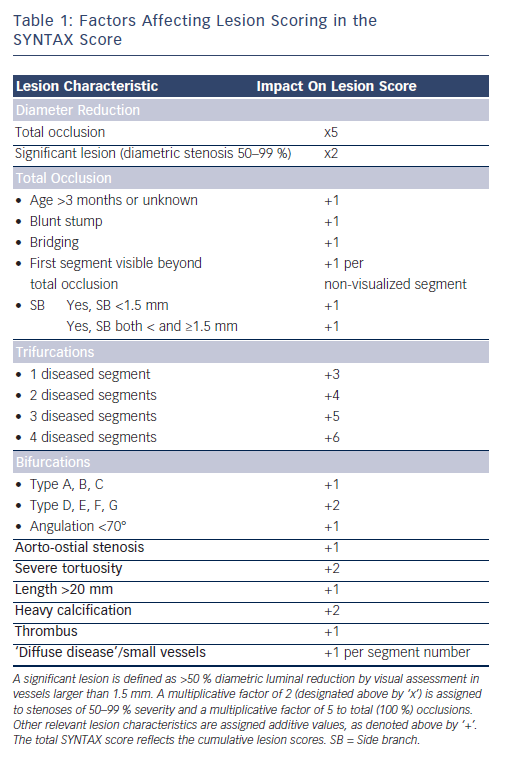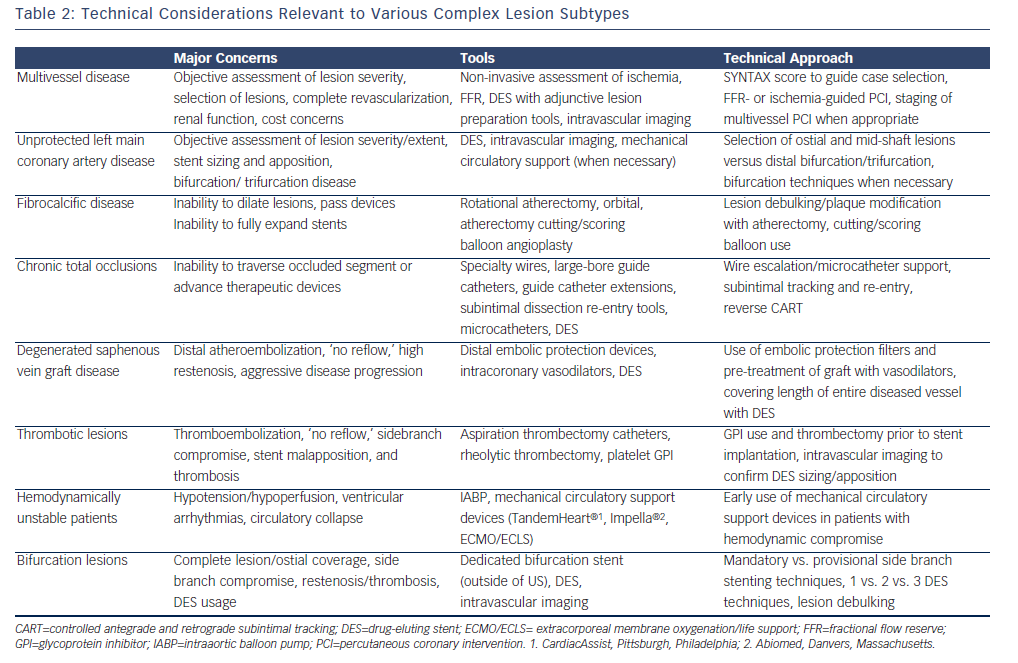Landscape of Contemporary Percutaneous Coronary Intervention and Challenges Associated with Specific Lesion Sets
What began as simple balloon dilation of single, de novo coronary lesions has evolved into myriad variations on the theme of complex coronary intervention, the majority involving the implantation of one or more DES and a significant proportion utilizing adjunctive devices for PCI guidance and optimization. Indeed, 60 % or more of the DES used in the US are implanted in an ‘off-label’ capacity (in terms of US Food and Drug Administration [FDA] labeling), often in the context of the complex coronary lesions described below or for patients with significant medical comorbidities.10–12 It bears mention that while complex PCI subsets abound in clinical practice, a uniformly adopted definition for complex coronary artery disease (CAD) is lacking in the cardiovascular literature. Lesion scoring schema such as the prospectively validated SYNergy between PCI with TAXUS™ and Cardiac Surgery (SYNTAX) score provide valuable guidance for the decision to intervene and the strategy of percutaneous intervention.13 In the SYNTAX score (www.syntaxscore.com), which incorporates aspects of many pre-existing scoring systems, additive or multiplicative numerical values are assigned via a computerized algorithm to each obstructive lesion noted, based on dominance, number of lesions, segments involved per lesion, and six additional groups of queries relating to lesion characteristics (see Table 1).13 The total SYNTAX score represents the sum of the individual lesions scores and has prognostic value independent of medical comorbidity and other patient-specific metrics. In the SYNTAX trial, which randomly assigned 1,800 patients with multivessel or left main coronary artery (LMCA) disease to coronary artery bypass graft (CABG) surgery versus PCI with DES, higher scores portended poorer outcomes with multivessel PCI.13–15
on the theme of complex coronary intervention, the majority involving the implantation of one or more DES and a significant proportion utilizing adjunctive devices for PCI guidance and optimization. Indeed, 60 % or more of the DES used in the US are implanted in an ‘off-label’ capacity (in terms of US Food and Drug Administration [FDA] labeling), often in the context of the complex coronary lesions described below or for patients with significant medical comorbidities.10–12 It bears mention that while complex PCI subsets abound in clinical practice, a uniformly adopted definition for complex coronary artery disease (CAD) is lacking in the cardiovascular literature. Lesion scoring schema such as the prospectively validated SYNergy between PCI with TAXUS™ and Cardiac Surgery (SYNTAX) score provide valuable guidance for the decision to intervene and the strategy of percutaneous intervention.13 In the SYNTAX score (www.syntaxscore.com), which incorporates aspects of many pre-existing scoring systems, additive or multiplicative numerical values are assigned via a computerized algorithm to each obstructive lesion noted, based on dominance, number of lesions, segments involved per lesion, and six additional groups of queries relating to lesion characteristics (see Table 1).13 The total SYNTAX score represents the sum of the individual lesions scores and has prognostic value independent of medical comorbidity and other patient-specific metrics. In the SYNTAX trial, which randomly assigned 1,800 patients with multivessel or left main coronary artery (LMCA) disease to coronary artery bypass graft (CABG) surgery versus PCI with DES, higher scores portended poorer outcomes with multivessel PCI.13–15
Challenges in contemporary catheter-based therapy for CAD generally stem from one or more of the following factors: the extent, severity, distribution, and characteristics of the coronary lesions, number of vessels diseased, LMCA involvement, presentation acuity and procedural urgency, burden of ischemia, hemodynamics/ventricular function, and medical comorbidities. Specific lesion sets that are associated with lower rates of procedural success andhigher rates of recurrence or major adverse cardiac events (MACE) include multivessel disease, unprotected LMCA disease, fibrocalcific or undilatable lesions, chronic total occlusions, degenerated saphenous vein graft lesions, thrombotic lesions, hemodynamically unstable patients, and bifurcation/trifurcation disease.
 Broad technical considerations relevant to each of these lesion subtypes are summarized in Table 2, with bifurcation disease also addressed below in greater detail. In a published Dynamic Registry PCI experience that predated the advent of DES, the majority (55.1 %) of attempted lesions fulfilled at least one of the aforementioned criteria for complexity with over a quarter of lesions demonstrating two or more complex characteristics.7 Similarly, following the introduction of DES in the US in 2003, investigators from the EVENT (Evaluation of Drug Eluting Stents and Ischemic Events) Registry found that the majority (60.2 %) of intervened lesions fulfilled either ACC/AHA B2 or C lesion criteria.16 Thus, a large proportion of contemporary PCI procedures invoke some measure of technical complexity. While it is beyond the scope of this article to discuss each of the aforementioned complex lesion subtypes in detail, suffice it to say that tools and validated strategies currently exist for each scenario listed. It is incumbent upon the operator aspiring to tackle complex disease in the catheterization laboratory, to gain intimate familiarity with these data and technical strategies.
Broad technical considerations relevant to each of these lesion subtypes are summarized in Table 2, with bifurcation disease also addressed below in greater detail. In a published Dynamic Registry PCI experience that predated the advent of DES, the majority (55.1 %) of attempted lesions fulfilled at least one of the aforementioned criteria for complexity with over a quarter of lesions demonstrating two or more complex characteristics.7 Similarly, following the introduction of DES in the US in 2003, investigators from the EVENT (Evaluation of Drug Eluting Stents and Ischemic Events) Registry found that the majority (60.2 %) of intervened lesions fulfilled either ACC/AHA B2 or C lesion criteria.16 Thus, a large proportion of contemporary PCI procedures invoke some measure of technical complexity. While it is beyond the scope of this article to discuss each of the aforementioned complex lesion subtypes in detail, suffice it to say that tools and validated strategies currently exist for each scenario listed. It is incumbent upon the operator aspiring to tackle complex disease in the catheterization laboratory, to gain intimate familiarity with these data and technical strategies.